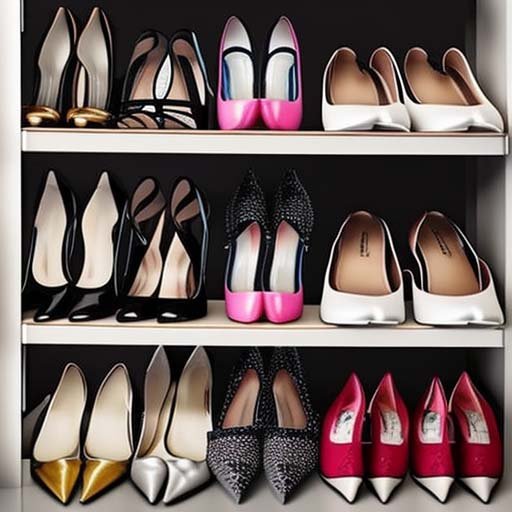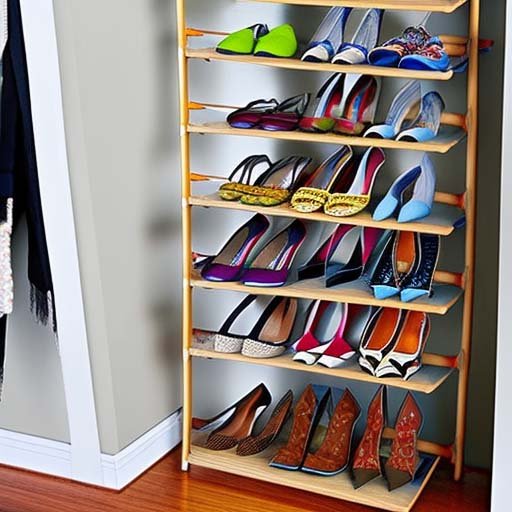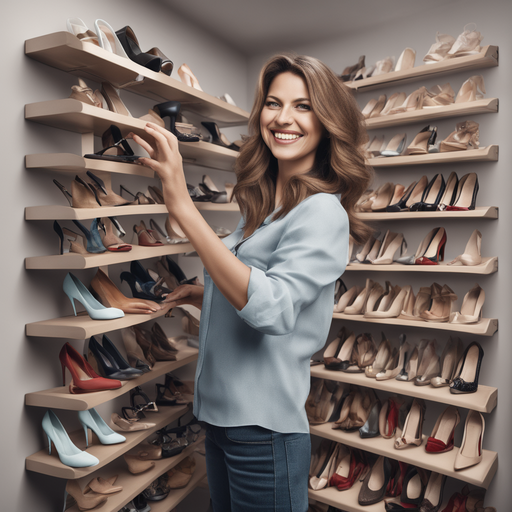Are you tired of having a messy pile of shoes by the door or struggling to find the right pair in a cluttered closet?
It’s time to invest in a shoe rack. A well-designed shoe rack not only helps you keep your shoes organized but also adds a touch of elegance to your living space. However, with so many options available in the market, it can be overwhelming to choose the right shoe rack that meets your needs.
In this article, we will walk you through the essential factors to consider before buying a shoe rack, ensuring that you make an informed decision and find the perfect shoe storage solution for your home.
Why Do You Need a Shoe Rack?
A shoe rack is not just a storage solution; it is an essential item for every household. Here are some reasons why you need a shoe rack:
- Organization: A shoe rack helps you keep your shoes in one place, preventing them from cluttering your living space.
- Protection: Proper storage on a shoe rack ensures that your shoes are protected from dust, moisture, and damage.
- Easy Access: With a shoe rack, you can easily find the pair of shoes you need, saving you time and effort.
- Preservation: By keeping your shoes properly organized, a shoe rack helps preserve their shape and quality, extending their lifespan.
- Aesthetic Appeal: A well-designed shoe rack adds a touch of style and elegance to your entryway or closet, enhancing the overall aesthetics of your home.
Size and Space Considerations
Before purchasing a shoe rack, it is crucial to consider the size and available space in your home. Here’s what you need to know:
Determining the Ideal Size
The size of the shoe rack depends on the number of shoes you own and the space you can allocate for it. Consider the following factors:
- Shoe Quantity: Take an inventory of your shoes to determine the number of pairs you need to accommodate on the shoe rack.
- Shoe Types: Consider the different types of shoes you own, such as sneakers, heels, boots, and flats, as they may have varying sizes and storage requirements.
- Future Growth: If you expect your shoe collection to grow, it’s wise to choose a shoe rack with extra storage capacity.
Assessing Available Space
Measure the area where you plan to place the shoe rack to ensure a perfect fit. Consider the following dimensions:
- Height: Measure the vertical space from the floor to the desired height for the shoe rack.
- Width: Measure the horizontal space available for the shoe rack.
- Depth: Measure the distance from the wall or the back of the closet to the front, accounting for the space needed for the shoes to fit comfortably.
Take note of any architectural features, such as baseboards or door swings, that may affect the placement and dimensions of the shoe rack.
Storage Capacity
The storage capacity of the shoe rack is crucial to ensure that it can accommodate all your shoes. Consider the following factors:
- Number of Shoes: Assess the total number of shoes you need to store and select a shoe rack with sufficient storage space.
- Shoe Size: If you wear larger shoe sizes or have family members with bigger feet, choose a shoe rack with wider compartments or adjustable shelves.
- Accessibility: Consider the ease of access to your shoes. A shoe rack with adjustable shelves or pull-out drawers allows for better visibility and accessibility.

Materials and Durability
The choice of material for your shoe rack affects both its durability and aesthetics. Here are some common materials used for shoe racks:
- Wood: Wooden shoe racks are durable, sturdy, and offer a timeless and classic look. They blend well with various interior styles. However, ensure that the wood is resistant to moisture to prevent damage to your shoes.
- Metal: Metal shoe racks are strong, durable, and provide excellent ventilation. They are suitable for high-traffic areas and can withstand heavy use.
- Plastic: Plastic shoe racks are lightweight, portable, and affordable. They are easy to clean and are ideal for temporary or budget-friendly storage solutions.
- Fabric: Fabric shoe racks are lightweight and collapsible, making them suitable for small spaces or temporary storage. However, they may not offer as much durability as other materials.
Consider the overall quality and construction of the shoe rack to ensure its longevity and functionality.
Design and Style
The design and style of the shoe rack play a significant role in its functionality and aesthetics. Here are some design considerations:
- Shoe Rack Type: Choose from different types of shoe racks, such as freestanding racks, wall-mounted racks, or over-the-door racks, based on your available space and preferences.
- Shelving Options: Consider the layout of the shelves. Adjustable shelves or stackable racks offer flexibility to accommodate different shoe sizes and types.
- Aesthetic Appeal: Select a shoe rack that complements your interior style and enhances the overall look of the room. Consider the color, finish, and decorative details to match your existing decor.
Remember that the design and style of the shoe rack should not compromise its functionality and storage capacity.
Open vs. Closed Shoe Racks
The choice between an open or closed shoe rack depends on personal preference and the specific needs of your shoes. Consider the following factors:
- Open Shoe Racks: Open shoe racks provide easy access and visibility to your shoes. They are suitable for frequently worn shoes and allow for better ventilation. However, they may require more frequent cleaning to prevent dust accumulation.
- Closed Shoe Racks: Closed shoe racks with doors or covers provide a clean and organized look. They protect your shoes from dust and keep them hidden from view. Closed shoe racks are ideal for formal shoes or shoes that are not worn as frequently.
Consider the pros and cons of each option and choose the one that best suits your needs and preferences.
Ventilation and Shoe Care
Proper ventilation is essential for maintaining the condition of your shoes. Consider the following:
- Ventilation Design: Look for shoe racks with adequate ventilation features, such as slatted shelves or mesh panels. Proper ventilation helps prevent moisture buildup and keeps your shoes fresh and odor-free.
- Shoe Care Considerations: Consider the specific care requirements of your shoes. Some shoes, such as leather or suede, may require additional airflow to maintain their quality. Ensure that the shoe rack you choose allows for proper air circulation to prevent mold or mildew growth.
Additional Features
While selecting a shoe rack, consider additional features that enhance its functionality and convenience. Here are some features to consider:
- Expandability: Choose a shoe rack that allows for easy expansion or customization as your shoe collection grows.
- Built-in Bench or Seating: Some shoe racks come with a built-in bench or seating area, providing a convenient spot for putting on or taking off your shoes.
- Accessory Storage: Look for shoe racks with additional storage compartments for accessories like shoe polish, shoehorns, or socks.
- Mobility: Consider shoe racks with wheels or casters for easy mobility, especially if you frequently rearrange your living space.
Evaluate these features based on your individual needs and preferences to find the perfect shoe rack that caters to your requirements.
Maintenance and Cleaning
To ensure the longevity and cleanliness of your shoe rack, follow these maintenance and cleaning tips:
- Regular Cleaning: Dust and wipe down the shoe rack regularly to prevent the buildup of dirt or debris. Use a soft cloth or a brush to clean the shelves and surfaces.
- Shoe Care: Keep your shoes clean and dry before storing them on the shoe rack to prevent any stains or odors from transferring onto the rack.
- Moisture Prevention: Place a mat or tray under the shoe rack to protect the floor from any moisture or dirt that may fall off the shoes.
Regular maintenance and cleaning will keep your shoe rack in excellent condition, ensuring that it continues to serve its purpose effectively.

Placement and Aesthetics
Consider the following factors when deciding where to place your shoe rack:
- Entryway: Placing a shoe rack near the entryway is convenient for storing and accessing shoes as you come and go. It helps keep your entrance tidy and prevents the spread of dirt throughout the house.
- Closet: A shoe rack inside the closet keeps your shoes organized and hidden from view. It maximizes closet space and helps create a clutter-free environment.
- Bedroom: If you have limited space in the entryway or closet, a shoe rack in the bedroom can provide a stylish and functional storage solution. Choose a shoe rack that matches your bedroom decor and complements the overall aesthetics of the room.
Consider the available space, traffic flow, and accessibility when determining the best placement for your shoe rack.
Conclusion
Choosing the right shoe rack is essential for keeping your shoes organized, protected, and easily accessible. Consider factors such as size, storage capacity, materials, design, ventilation, and additional features to find the perfect shoe rack that meets your needs and complements your home décor. By taking the time to evaluate these considerations and investing in a high-quality shoe rack, you can enjoy a clutter-free living space and ensure the longevity of your beloved shoe collection. So, go ahead and find the shoe rack that will transform your shoe storage experience.

